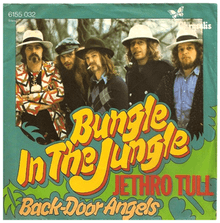Bungle in the Jungle
"Bungle in the Jungle" is a song by British progressive rock band Jethro Tull. It was released on their album War Child in 1974.
| "Bungle in the Jungle" | ||||
|---|---|---|---|---|
 | ||||
| Single by Jethro Tull | ||||
| from the album War Child | ||||
| B-side | "Back-Door Angels" | |||
| Released | 14 October 1974 (US) 26 October 1974 (UK) | |||
| Recorded | 1974 at Morgan Studios, London | |||
| Genre | Progressive rock | |||
| Length | 3:35 | |||
| Label | Chrysalis | |||
| Songwriter(s) | Ian Anderson | |||
| Producer(s) | Ian Anderson | |||
| Jethro Tull singles chronology | ||||
| ||||
A remnant from the band's abandoned "Chateau D'Isaster Tapes", "Bungle in the Jungle" features lyrics based on analogies between animals and humans. The song was later released as a single, becoming a top 20 hit in the United States and top 5 in Canada.
Despite the song's American success, Anderson saw the song as too commercial and a minor song in the band's catalogue outside of North America.
Background
Following the success of the band's 1972 album Thick as a Brick, Jethro Tull spent time in Paris to record the unfinished "Chateau D'isaster Tapes". According to Jethro Tull bandleader Ian Anderson, the unfinished album was intended to focus on "exploring people, the human condition, through analogies with the animal kingdom."[1] Though a finished version was never released, some of the songs originally intended for the project appeared on the albums A Passion Play and War Child; Anderson later said, "That particular song was perhaps the more obvious and the more catchy of the tunes [from the sessions]."[1]
When asked whether the song title was based on the infamous "Rumble in the Jungle" boxing match, Anderson responded, "'Bungle in the Jungle' had been released in the year 1974 on the War Child album, "rumble in the jungle" may have been taken from that. Because that took place on the 30th of October in 1974. Maybe they were alluding to what was a well-played song, even on AM radio. ... it certainly did [come first] in terms of writing it. As to the actual time of release, I can't be 100 percent sure on that. But chances are it was somewhere prior to that."[1]
Release
"Bungle in the Jungle", according to Anderson, was "finished and saved in time for the War Child album".[1] In addition to being released on War Child in 1974, "Bungle in the Jungle" was released as a single, backed with "Back-Door Angels". The single was one of Jethro Tull's most successful US single releases ever, reaching number 12 on the Billboard charts.[2] The single spent 16 weeks on the American charts was the band's second and final top 40 hit in the United States, after 1969's "Living in the Past".[2] "Bungle in the Jungle" also reached number four in Canada.[3] It was the 51st biggest Canadian hit of 1975.[3]
Despite the song's North American commercial success, Anderson has since said of the song, "I feel self-conscious about it because I wrote it for radio play; it just feels a little too deliberate."[4] He also noted the song's relative lack of success outside of America, saying "[the song] doesn't mean much anywhere else."[4]
Chart performance
Personnel
- Jethro Tull
- Ian Anderson – flute, acoustic guitar, vocals
- Martin Barre – electric guitar, Spanish guitar
- John Evan – piano, organ, synthesisers, accordion
- Jeffrey Hammond – bass guitar
- Barriemore Barlow – drums, percussion
- Additional personnel
- David Palmer – orchestral arrangements
- Robin Black - Sound engineer
- Terry Ellis - Executive Producer
References
- Wiser, Carl. "Songwriter Interviews: Ian Anderson of Jethro Tull". SongFacts. Retrieved 15 February 2019.
- "Jethro Tull: Chart History". Billboard. Retrieved 15 February 2019.
- "Top Singles - Volume 22, No. 24, February 08 1975". Collectionscanada.gc.ca. Library and Archives Canada. Archived from the original on August 17, 2016.
- Sheckter, Alan. "Grateful Web Interview w/ Ian Anderson". Grateful Web. Retrieved 15 February 2019.
- David Kent's "Australian Chart Book 1970-1992" Archived 2016-03-05 at the Wayback Machine
- Joel Whitburn's Top Pop Singles 1955-1990 - ISBN 0-89820-089-X
- Whitburn, Joel (1999). Pop Annual. Menomonee Falls, Wisconsin: Record Research Inc. ISBN 0-89820-142-X.